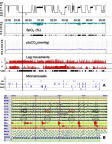Sleep disturbances in patients with amyotrophic lateral sclerosis: current perspectives
- PMID: 31496852
- PMCID: PMC6701267
- DOI: 10.2147/NSS.S183504
Sleep disturbances in patients with amyotrophic lateral sclerosis: current perspectives
Abstract
Amyotrophic lateral sclerosis (ALS) is a progressive motor neuron disease inevitably leading to generalized muscle weakness and premature death. Sleep disturbances are extremely common in patients with ALS and substantially add to the burden of disease for both patients and caregivers. Disruption of sleep can be caused by physical symptoms, such as muscle cramps, pain, reduced mobility, spasticity, mucus retention, and restless legs syndrome. In addition, depression and anxiety may lead to significant insomnia. In a small subset of patients, rapid eye movement (REM) sleep behavioral disorder may be present, reflecting neurodegeneration of central nervous system pathways which are involved in REM sleep regulation. With regard to overall prognosis, sleep-disordered breathing (SDB) and nocturnal hypoventilation (NH) are of utmost importance, particularly because NH precedes respiratory failure. Timely mechanical ventilation is one of the most significant therapeutic measures to prolong life span in ALS, and transcutaneous capnometry is superior to pulse oxymetry to detect NH early. In addition, it has been shown that in patients on home ventilatory support, survival time depends on whether normocapnia, normoxia, and elimination of apneic events during sleep can be reliably achieved. Several studies have investigated sleep patterns and clinical determinants of sleep disruption in ALS, but exact prevalence numbers are unknown. Thus, constant awareness for sleep-related symptoms is appropriate. Since no curative treatment can be offered to affected patients, sleep complaints should be thoroughly investigated in order to identify any treatable etiology and improve or stabilize quality of life as much as possible. The use of hypnotics should be confined to palliation during the terminal phase and refractory insomnia in earlier stages of the disease, taking into account that most compounds potentially aggravate SDB.
Keywords: amyotrophic lateral sclerosis; health-related quality of life; non-invasive ventilation; sleep disorders; sleep-disordered breathing.
Conflict of interest statement
Dr Matthias Boentert reports grants from Sanofi-Genzyme GmbH and Loewenstein Medical GmbH, outside the submitted work, and no other conflicts of interest in this work.
Figures



Similar articles
-
Sleep and Sleep Disruption in Amyotrophic Lateral Sclerosis.Curr Neurol Neurosci Rep. 2020 May 27;20(7):25. doi: 10.1007/s11910-020-01047-1. Curr Neurol Neurosci Rep. 2020. PMID: 32462331 Free PMC article. Review.
-
Effects of non-invasive ventilation on objective sleep and nocturnal respiration in patients with amyotrophic lateral sclerosis.J Neurol. 2015 Sep;262(9):2073-82. doi: 10.1007/s00415-015-7822-4. Epub 2015 Jun 17. J Neurol. 2015. PMID: 26076745
-
[Obstructive sleep apnea hypopnea syndrome and alveolar hypoventilation syndrome in motor neuron disease: A case report and literature review].Zhong Nan Da Xue Xue Bao Yi Xue Ban. 2018 Jan 28;43(1):106-112. doi: 10.11817/j.issn.1672-7347.2018.01.017. Zhong Nan Da Xue Xue Bao Yi Xue Ban. 2018. PMID: 30154300 Review. Chinese.
-
Prevalence of sleep apnoea and capnographic detection of nocturnal hypoventilation in amyotrophic lateral sclerosis.J Neurol Neurosurg Psychiatry. 2018 Apr;89(4):418-424. doi: 10.1136/jnnp-2017-316515. Epub 2017 Oct 20. J Neurol Neurosurg Psychiatry. 2018. PMID: 29054915
-
Sleep disorders in amyotrophic lateral sclerosis: A questionnaire-based study from India.Neurol India. 2018 May-Jun;66(3):700-708. doi: 10.4103/0028-3886.232327. Neurol India. 2018. PMID: 29766929
Cited by
-
The glymphatic system: a new perspective on brain diseases.Front Aging Neurosci. 2023 Jun 15;15:1179988. doi: 10.3389/fnagi.2023.1179988. eCollection 2023. Front Aging Neurosci. 2023. PMID: 37396658 Free PMC article. Review.
-
TDP-43 impairs sleep in Drosophila through Ataxin-2-dependent metabolic disturbance.Sci Adv. 2024 Jan 12;10(2):eadj4457. doi: 10.1126/sciadv.adj4457. Epub 2024 Jan 10. Sci Adv. 2024. PMID: 38198547 Free PMC article.
-
[Clinical features of sleep-disordered breathing in children with neuromuscular disease].Zhongguo Dang Dai Er Ke Za Zhi. 2021 Feb;23(2):158-163. doi: 10.7499/j.issn.1008-8830.2011030. Zhongguo Dang Dai Er Ke Za Zhi. 2021. PMID: 33627211 Free PMC article. Chinese.
-
Using patient-reported symptoms of dyspnea for screening reduced respiratory function in patients with motor neuron diseases.J Neurol. 2020 Nov;267(11):3310-3318. doi: 10.1007/s00415-020-10003-5. Epub 2020 Jun 23. J Neurol. 2020. PMID: 32577867 Free PMC article.
-
Defining novel functions for cerebrospinal fluid in ALS pathophysiology.Acta Neuropathol Commun. 2020 Aug 20;8(1):140. doi: 10.1186/s40478-020-01018-0. Acta Neuropathol Commun. 2020. PMID: 32819425 Free PMC article. Review.
References
-
- Mizutani T, Aki M, Shiozawa R, et al. Development of ophthalmoplegia in amyotrophic lateral sclerosis during long-term use of respirators. J Neurol Sci. 1990;99(2–3):311–319. - PubMed
LinkOut - more resources
Full Text Sources
Miscellaneous

